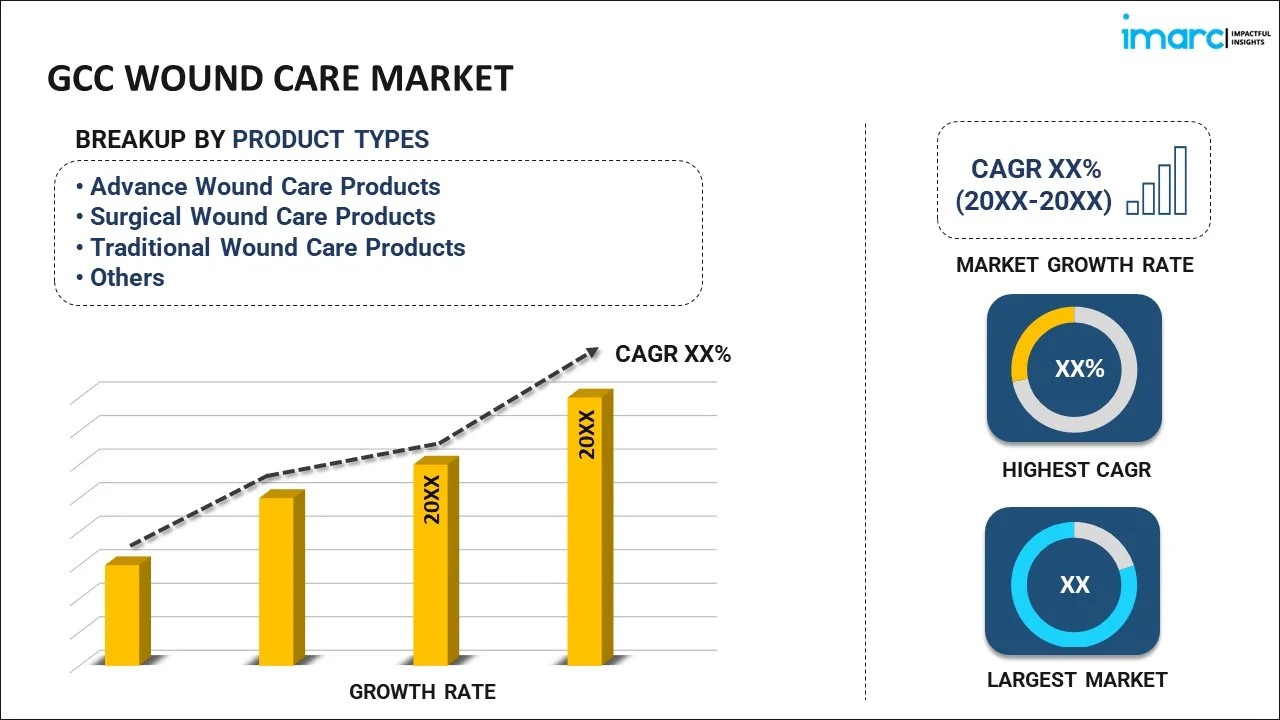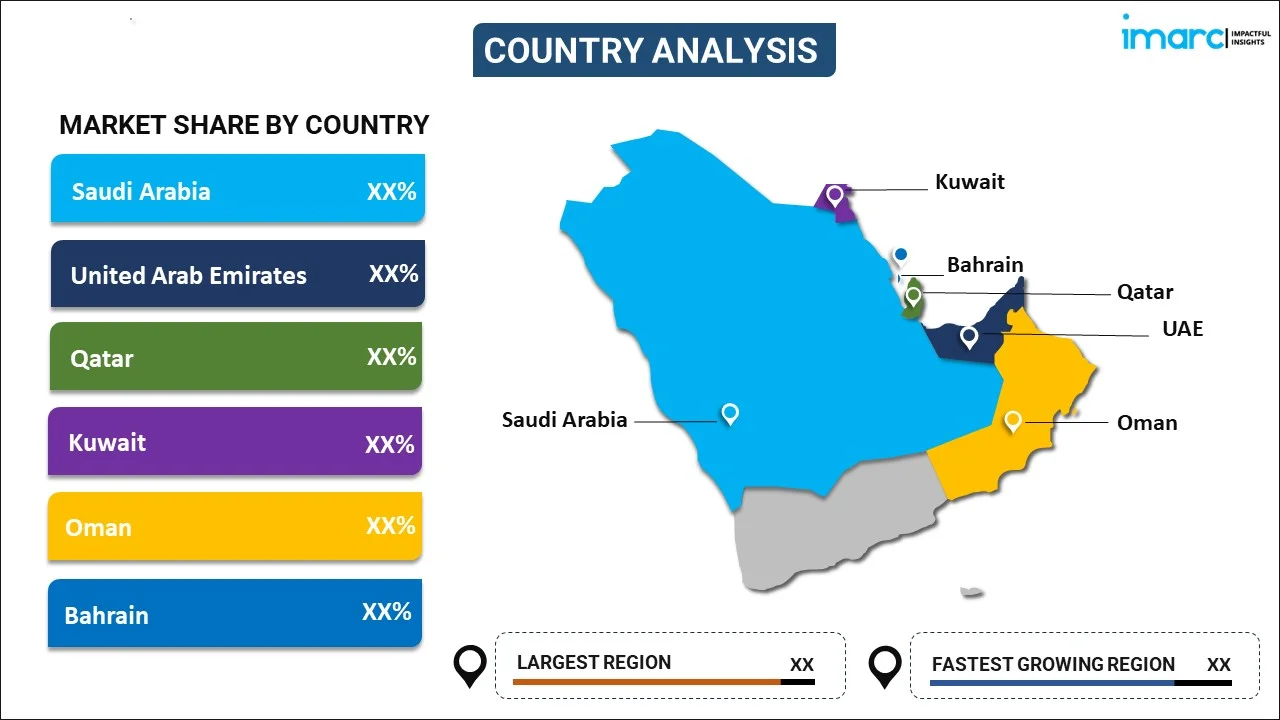
GCC Wound Care Market Report by Product Type (Advance Wound Care Products, Surgical Wound Care Products, Traditional Wound Care Products, Active Wound Care Products, Wound Therapy Devices Products), Wound Type (Chronic Wounds, Acute Wounds), End User (Hospitals & Clinics, Long-Term Care Facilities, Home Care Setting, and Others), and Country 2025-2033
Market Overview:
The GCC wound care market size is projected to exhibit a growth rate (CAGR) of 5.39% during 2025-2033. The increasing incidence of chronic wounds, advancements in wound care technology, growing awareness and education, investments in healthcare infrastructure, regulatory support and standards, and increasing number of collaborations and partnerships represent some of the key factors driving the market.
|
Report Attribute
|
Key Statistics
|
|---|---|
|
Base Year
|
2024
|
|
Forecast Years
|
2025-2033
|
|
Historical Years
|
2019-2024
|
| Market Growth Rate 2025-2033 | 5.39% |
Wound care is a specialized field of medicine that focuses on the management of wounds to promote proper healing and reduce the risk of infection. The definition of wound care encompasses the assessment, diagnosis, and treatment of wounds, considering factors such as the wound type, size, location, and individual patient needs. The characteristics of wound care include the meticulous application of appropriate cleansing and dressing methods, vigilant monitoring for signs of infection, and recognizing underlying conditions that may influence healing. A multidisciplinary approach often characterizes it, involving various healthcare professionals to tailor the treatment to each specific wound. Moreover, the features of wound care entail selecting suitable dressings and applying therapies such as debridement, moisturization, and pressure relief. It may also involve advanced treatment modalities like negative pressure wound therapy or the utilization of specialized creams and ointments. Educating patients on proper wound care techniques and preventive measures is another vital feature. Wound care's complexity requires a precise understanding of the wound's nature, coupled with individualized care planning, and it plays an essential role in preventing complications. All these elements come together to make wound care a vital component in healthcare, reflecting a commitment to patient well-being and quality of life.
GCC Wound Care Market Trends:
The increasing incidence of chronic wounds and the need for advanced wound care solutions represent some of the critical factors driving the growth of the wound care market in the GCC region. Additionally, the wide application of wound care products across different healthcare sectors, such as hospitals, clinics, and home care, is emphasizing its importance, thereby boosting the market growth. Moreover, the increasing number of collaborations between healthcare institutions and medical product manufacturers are enhancing the treatment capabilities, thereby supporting the market growth. Besides this, the formulation of medical standards and protocols in alignment with patient safety and wound healing efficiency is contributing to market expansion. Alongside this, the emergence of localized medical facilities equipped with specialized wound care professionals and products is meeting the specific healthcare needs of the region, stimulating the market growth. In addition to this, efforts to enhance healthcare infrastructure and medical practices related to wound prevention and management are creating a positive outlook for the market. The growing awareness about wound care best practices, coupled with the strategic inclusion of innovative wound care products and techniques, is further driving the market growth. The focus on patient needs and maintaining a high standard of care is also fostering the development of the market. Other factors, such as the adoption of advanced wound care technology, significant investments in research and development, and a robust commitment to healthcare excellence, are creating a positive outlook for the wound care market across the GCC region.
GCC Wound Care Market Segmentation:
IMARC Group provides an analysis of the trends in each segment of the GCC wound care market report, along with forecasts at the regional and country levels for 2025-2033. Our report has categorized the market based on product type, wound type, and end user.
Product Type Insights:

- Advance Wound Care Products
- Foam Dressing
- Hydrocolloid Dressing
- Film Dressing
- Alginate Dressing
- Hydrogel Dressing
- Collagen Dressing
- Others
- Surgical Wound Care Products
- Sutures
- Staplers
- Tissue Adhesive, Sealants & Hemostats
- Anti-effective Dressing
- Traditional Wound Care Products
- Medical Tapes
- Cleansing Agent
- Active Wound Care Products
- Biological Skin Substitutes
- Topical Agents
- Wound Therapy Devices Products
- Negative Pressure Wound Therapy
- Oxygen and Hyperbaric Oxygen Equipment
- Electric Stimulation Devices
- Pressure Relief Devices
- Wound Assessment & Monitoring Devices
- Others
The report has provided a detailed breakup and analysis of the market based on the product type. This includes advance wound care products (foam dressing, hydrocolloid dressing, film dressing, alginate dressing, hydrogel dressing, collagen dressing, and others), surgical wound care products (sutures, staplers, tissue adhesive, sealants & hemostats, and anti-effective dressing), traditional wound care products (medical tapes and cleansing agent), active wound care products (biological skin substitutes, and topical agents), and wound therapy devices Products (negative pressure wound therapy, oxygen and hyperbaric oxygen equipment, electric stimulation devices, pressure relief devices, wound assessment & monitoring devices, others).
Wound Type Insights:
- Chronic Wounds
- Diabetics Ulcers
- Pressure Ulcers
- Venous Leg Ulcers
- Others
- Acute Wounds
- Surgical Traumatic Wounds
- Burns
A detailed breakup and analysis of the market based on the wound type has also been provided in the report. This includes plastic chronic wounds (diabetics ulcers, pressure ulcers, venous leg ulcers, and others) and acute wounds (surgical traumatic wounds and burns).
End User Insights:
- Hospitals & Clinics
- Long-Term Care Facilities
- Home Care Setting
- Others
A detailed breakup and analysis of the market based on the end user has also been provided in the report. This includes hospitals & clinics, long-term care facilities, home care setting, and others.
Country Insights:

- Saudi Arabia
- UAE
- Qatar
- Bahrain
- Kuwait
- Oman
The report has also provided a comprehensive analysis of all the major regional markets, which include Saudi Arabia, the UAE, Qatar, Bahrain, Kuwait, and Oman.
Competitive Landscape:
The report has also provided a comprehensive analysis of the competitive landscape in the market. Competitive analysis such as market structure, key player positioning, top winning strategies, competitive dashboard, and company evaluation quadrant has been covered in the report. Also, detailed profiles of all major companies have been provided.
GCC Wound Care Market Report Scope:
| Report Features | Details |
|---|---|
| Base Year of the Analysis | 2024 |
| Historical Period | 2019-2024 |
| Forecast Period | 2025-2033 |
| Units | Million USD |
| Scope of the Report | Exploration of Historical and Forecast Trends, Industry Catalysts and Challenges, Segment-Wise Historical and Predictive Market Assessment:
|
| Product Types Covered |
|
| Wound Types Covered |
|
| End Users Covered | Hospitals & Clinics, Long-Term Care Facilities, Home Care Setting, Others |
| Countries Covered | Saudi Arabia, the UAE, Qatar, Bahrain, Kuwait, Oman |
| Customization Scope | 10% Free Customization |
| Post-Sale Analyst Support | 10-12 Weeks |
| Delivery Format | PDF and Excel through Email (We can also provide the editable version of the report in PPT/Word format on special request) |
Key Questions Answered in This Report:
- How has the GCC wound care market performed so far and how will it perform in the coming years?
- What has been the impact of COVID-19 on the GCC wound care market?
- What is the breakup of the GCC wound care market on the basis of product type?
- What is the breakup of the GCC wound care market on the basis of wound type?
- What is the breakup of the GCC wound care market on the basis of end user?
- What are the various stages in the value chain of the GCC wound care market?
- What are the key driving factors and challenges in the GCC wound care market?
- What is the structure of the GCC wound care market and who are the key players?
- What is the degree of competition in the GCC wound care market?
Key Benefits for Stakeholders:
- IMARC’s report offers a comprehensive quantitative analysis of various market segments, historical and current market trends, market forecasts, and dynamics of the GCC wound care market from 2019-2033.
- The research study provides the latest information on the market drivers, challenges, and opportunities in the GCC wound care market.
- Porter's five forces analysis assist stakeholders in assessing the impact of new entrants, competitive rivalry, supplier power, buyer power, and the threat of substitution. It helps stakeholders to analyze the level of competition within the GCC wound care industry and its attractiveness.
- Competitive landscape allows stakeholders to understand their competitive environment and provides an insight into the current positions of key players in the market.
Need more help?
- Speak to our experienced analysts for insights on the current market scenarios.
- Include additional segments and countries to customize the report as per your requirement.
- Gain an unparalleled competitive advantage in your domain by understanding how to utilize the report and positively impacting your operations and revenue.
- For further assistance, please connect with our analysts.
 Inquire Before Buying
Inquire Before Buying
 Speak to an Analyst
Speak to an Analyst
 Request Brochure
Request Brochure
 Request Customization
Request Customization




.webp)




.webp)












